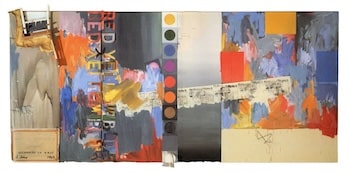According to What, 1964 by Jasper Johns

Johns created this expansive, seven by 16 foot painting by joining several canvases together, as well as by adding various found objects to the painted panels. He included techniques that appeared in earlier works, like "brushmarking," the stenciled names of colors, and cast body parts. He also expanded his visual repertoire through his inclusion of elements like silkscreened newspaper pages that discussed the Kremlin in the center of the painting. While Andy Warhol and Robert Rauschenberg used silkscreening as a convenient method of reproducing photographs in paintings without evidence of the artist's hand, Johns fervently painted into and around the screened headlines, reinforcing the idea of the intertwining of artist and device explored in Periscope (Hart Crane) (1962). On the far left side, as an ode to his mentor, he attached a small canvas with the silhouette of Marcel Duchamp so only the back with the stretchers, date, title, and Johns' signature were visible. Above this small canvas, he also attached a vertical cross-section of a chair, with a mold of a leg seated in it, turned upside down. Johns added the found objects to create a painting that "allows things to change" as the lights and viewers shift around the work. This shift in focus illustrated Johns' belief that we all experience the world through multiple fragments viewed in shifting contexts from varying perspectives.
